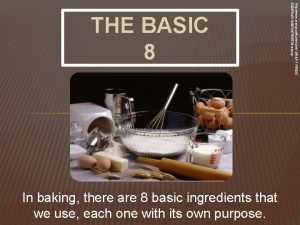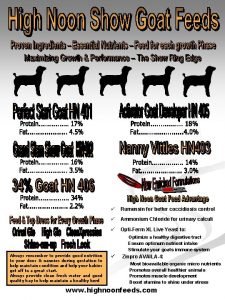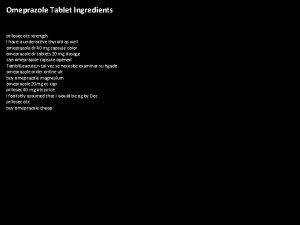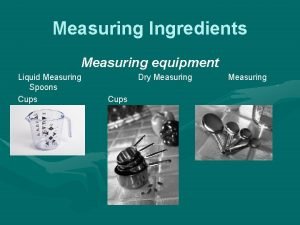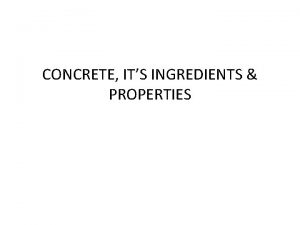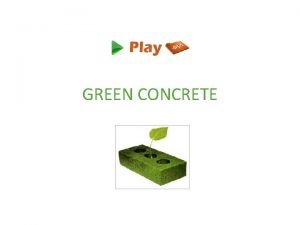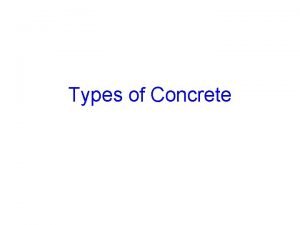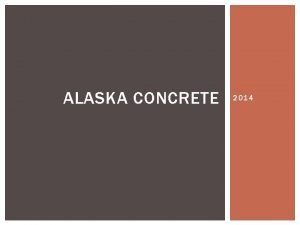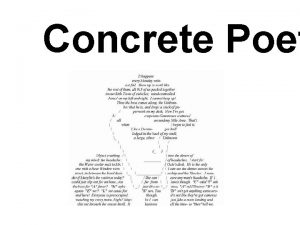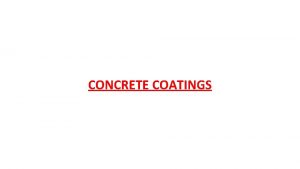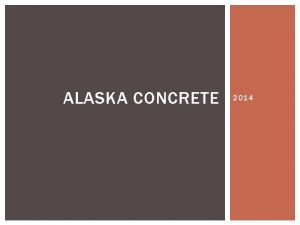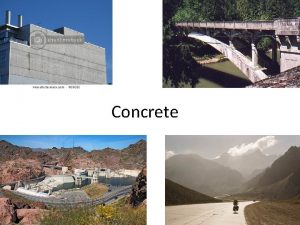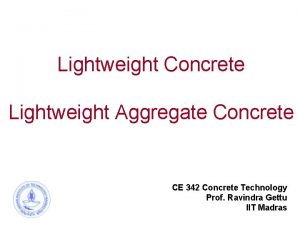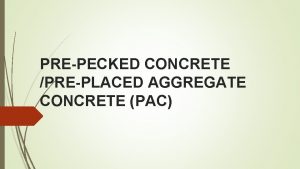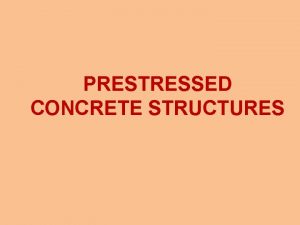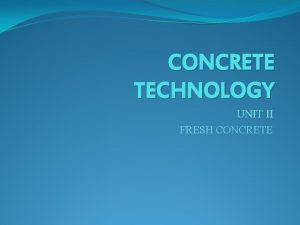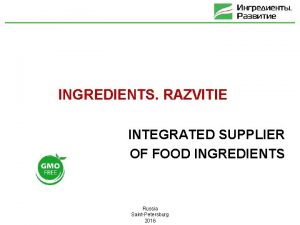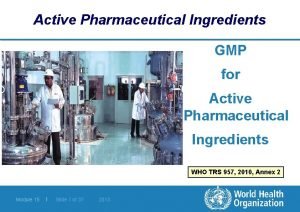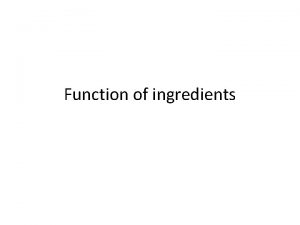Concrete Concrete Main Primary Ingredients n n n




















- Slides: 20

Concrete

Concrete Main Primary Ingredients n n n Cement Aggregate Water

Cement n Been around for at least 2 thousand yrs n n Romans used them – found cements from natural mixtures of limestone and clay Portland Cement n n n 1824 the first modern step was taken by Joseph Aspdin – produces a powder from limestone and clay Called it Portland Cement because it resembled a stone quarried near Portland, England Been improved since then and produces under strict guidelines today

Portland Cement Ingredients n n Lime, silica, alumina and iron 4 parts limestone to 1 part clay

Portland Cement Types 1. 2. 3. 4. 5. 10 Normal – general work 20 Moderate – better resistant to sulfate – lower temp rise 30 – high early strength – fast curing (cold weather) 40 – low heat – lower heat – slower curing 50 – sulfate resistant – subject to attack from sulfate (salt)

Portland Cement Packaging n n Bags – 94 pounds per bag – equal to one cubic foot volume Or by the truck load

Cement Admixtures n Air entraining – contains small amounts of additives that case microscopic air bubbles to form the concrete 2 to 8 percent finished volume n Give improved workability n Gives better resistance to freeze and thaw cycle n With same structural strength n

Aggregates n n Makes up ¾ of concrete mixtures Qualities n n n Strong Resistant to freeze thaw cycle Chemically stable Properly sized In general aggregate size must be no greater then ¾ size of the opening it needs to be placed in including reinforcement

Typical Aggregated sizes n n n ¾” –thin slabs ¾” to 1 -1/2” – slabs structural work Up to 6 in – Dams and other large projects

Making and placing Concrete n Rules for making high quality concrete n n n Water to cement ratio – major factor in strength of concrete – less water stronger n n Use clean sound ingredients Mix them in the correct proportions Handle the wet concrete properly to avoid segregation Cure the concrete carefully But water is needed to hydrate the mixture – gives necessary fluidity and plasticity for placing and finishing Absolute water-cement ratio under. 60 – weight of water in mixture

Handling and Placing Concrete n n Wet concrete is not a liquid – but a slurry – unstable mixture of solids and liquid Segregate – move horizontally any distance in formwork n n Dropped from height Vibrated excessively

Curing Concrete n Concrete cures through hydration n n Must be kept moist until its required strength is achieved Takes a long time 28 days typically If allowed to dry during the time it will lose strength

Concrete Weights n Normal weight concretes n n n Structural lightweight n n n 85 to 135 lb/ft 3 Made with expanded clay shale slate and slag Insulating concrete n n n 135 to 160 lb/ft 3 Made with sand gravel and crushed stone 15 to 85 lb/ft 3 Made with prumice, scoria, prelite, vemiculite dhatomite Heavy weight concrete n n 175 to 400 lb/ft 3 Made with hernalite, barite, limonite, iron, steel

Concrete Testing n Slump test n n Slump cone 12 in high 8 in dia. At bottom The cone is filled in three equal layers each being tampered 25 times with a 5/8 in bullet nose tampering rod Cone is filled and level off it is then lifted and carefully – the amount of slump is then measured Compressive Strength Test n n n Concrete specimens are usually cylindrical with a length equal to twice its diameter The mold is filled in three equal parts and tampered 25 times with standard tamping rod between layers When mold is full it is struck off and level and covered with a glass or metal plate to prevent evaporation The specimens are removed from mold after 24 hours and place in the curing location At the end of the curing period the specimens are subject to a compression test

Concrete Admixtures n An admixture which is used to speed up the initial set of concrete is called an accelerator n n The function of a retarded is to delay or extend the setting time of the cement paste in concrete n n n A proper amounts of air improved workability, easier placing, increased durability, better resistance to frost action, improve flow in concrete pump lines and reduction in bleeding and water gain. Air entrained concrete contains microscopic bubbles of air formed with the aid of group of chemicals called surface active agents, material which have property of reducing the surface tension of water Air entrainment may have adverse effects on the strength of concrete – the decrease in strength is proportional to the amount of air contents Super plasticizer – is a substance that disperse the clumps by coating each cement particle thus separating and dispersing the cement in the water. n n Used when concrete is set in hot, low humidity, and winding conditions Most common retarders are carbohydrate derivatives and calcium liginsulfonate The introduction of controlled amounts of air into a mix has proved to be an important advance in concrete engineering n n Most common is calcium chloride When cement and water are mixed the cement particles tend to gather in clumps known as cement agglomerates, this clumping action prevents through mixing of cement and water producing a loss in the workability of the concrete mix as well as preventing complete hydration of the cement producing a less then full potential of strength To prolong the life expectancy of the concrete surface, in addition to proper curing and finishing concrete hardeners are added to concrete mix

Reinforcing Concrete n n Concrete has no useful tensile strength shear and bending Steel and concrete change dimension nearly at the same rate Steel is protected from corrosion by the alkaline chemistry of concrete plus concrete bonds strongly to steel Theory of concrete reinforcing is extremely simple n n Bars are rolled into 11 standard diameters in numbers of 1/8” n n Bar size 3 to 18 Bars come in 3 grades 40 -50 -60 n n Put steel where there is tension in the concrete member 40, 000 psi 50, 000 psi 60, 000 psi Reinforcing steel is also produced in sheets or rolls of welded wire fabric n n Used to reinforce slabs on grade Principal advantage is economy of labor (easy to place)

Precast Concrete n Advantages of Precast n n n Casting and curing conditions as well as concrete design can be rigidly controlled, resulting in consistently high quality concrete Close supervision and control of materials and a specialized work force in a centralized plant also help to produce a high quality product Finishing work on concrete surfaces can be done more easily and efficiently in a plant than in position on the site The cost of form work is reduced since it can be set up on the ground rather than begin suspended or supported in position Because of superior reinforcing techniques the load carrying ability of a member may be increase while at the same time reducing its dead load by reducing the amount of concrete required Plant production is not normally subject to delays due to adverse weather conditions as are job site operations

Precast Concrete n Precast structural members fall into two general classifications Normally reinforced n Prestressed n n Prestressed broken down into two categories Pretensioned n posttensioned n

Pre stressed Concrete n A prestressed concrete unit is one into which engineered stresses have been introduced before it has been subjected to a load n Pretensioning n n High strength steel strands are stretched tightly then concrete is pour concrete bonds together with the steel after it has cured the concrete unit is place in compression Posttensioning n High strength steel strands are stretched tightly then concrete is poured , cured then the steel is tensioned usually done in place

Pre stressed Concrete n There are some distinct advantages to producing architectural precast units in a central plant n n n Design freedom High degree of quality control of both the ingredients and the finished techniques The shapes, sizes and configurations of units for are building may be as diversified or similar as the designer wishes The possibility of including in the precast units some or all of the services which are normally installed after erection The speed at which a building can be closed in reducing cost and allowing earlier access by the service trades.
 Give the eight baking ingredients
Give the eight baking ingredients Chapter 29 light cured gels
Chapter 29 light cured gels Concrete semi concrete abstract
Concrete semi concrete abstract Concrete semi concrete abstract
Concrete semi concrete abstract Ways of expressing future time
Ways of expressing future time Whats a main idea
Whats a main idea Void main int main
Void main int main Epiglottis
Epiglottis Magenta cyan and yellow are the ____ color. *
Magenta cyan and yellow are the ____ color. * Asea via source
Asea via source Dushivishari agad
Dushivishari agad High noon ingredients
High noon ingredients E excel noco benefits
E excel noco benefits Asea renu 28 ingredients
Asea renu 28 ingredients Quick bread ingredients functions
Quick bread ingredients functions What are the ingredients and proportions in 3-2-1 dough
What are the ingredients and proportions in 3-2-1 dough Omeprazole sediaan tablet
Omeprazole sediaan tablet Food analogs examples
Food analogs examples Angioprim
Angioprim Examples of solid ingredients
Examples of solid ingredients Ice power hot
Ice power hot
